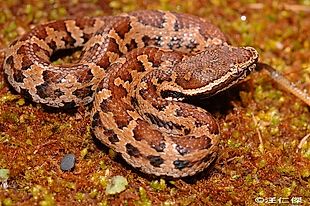Trimeresurus gracilis
Taiwan Mountain Pitviper
菊池氏龜殼花 (ju2chi3shi4gui1ke3hua1)
Status: Protected (Cat. III)
VENOMOUS!
More Photos
Family
Viperidae; subfamily Crotalinae (Pitvipers)
Max. length
60 cm
Occurrence in Taiwan
Throughout Taiwan, mainly at elevations above 2000 m. Rare.
Global Distribution
Endemic to Taiwan
Description
Small snake; total length up to 60 cm. There are 15-27 (19-21 at mid-body) rows of scales, which are keeled and rough, except for the first or second scale rows. Head is broad, roughly triangular, covered with small scales, and distinct from neck; body is stout or robust; tail is small. There is a prominent angular ridge from upper eye to end of nose, and a prominent pit between eye and nostril. Eye is medium-sized, high on head, forms slight bulge on upper head. Iris is light brown to tan dappled with dark pigment which blends with color of head, and there may be a horizontal brown to brown-black band of diffuse pigment across middle of eye, which is in line with dark brown band posterior to eye. Pupil is vertically elliptical, black, with narrow, indistinct margin of white. Tongue is dark gray to black, with stem lighter than fork tips. Fangs are large, movable, in sheath in anterior part of upper jaw. Upper head is brown to dark brown, with designs of darker brown of varying intensities; there is a dark band extending from eye to corner of mouth which is bordered by stripes of whitish or light brown. Sides of head are dirty white to tan, or white and mosaicked with black. Upper body is light brown to red brown with many designs or shades of chocolate to brown black; there is a mid-dorsal series of dark designs, and a lateral one on each side which tends to be in line with the mid-dorsal one. The dark designs may or may not have narrow whitish margins. Some individuals may bear white small dots on tail. Ventral head is dirty white to tan and may be shaded by varying quantities of scattered black pigment. Ventral body is dirty white to light brown, gradually darker toward posterior part of body; it is conspicuously mottled with diffuse black to red brown spots, which may be square and arranged roughly as a checkerboard or form moderately broad irregular longitudinal lines along sides. Anal scale is entire, and subcaudals are paired.
Biology & Ecology
This cathemeral (diurnal or nocturnal) pitviper inhabits mountainous regions and can be frequently found under arrow bamboo or stones. It preys on amphibians, lizards, or small mammals. It mates in spring and summer; females give birth to 2-8 young per litter in late summer and fall. Hatchlings measure about 18 cm in total length. Females and males mature in 3 and 2 years, respectively. Its venom contains hemorrhagic toxins, and the wound often swells up.
Etymology
Trimeresurus: "The meaning of Trimeresurus, which suggests 'three-part tail', is obscure." (Gotch, A.F. 1986. Reptiles - Their Latin Names Explained. - Blandford Press. 176 pp.);
gracilis: Latin for "slender".
The Chinese name 菊池氏龜殼花 (ju2chi3shi4gui1ke3hua1) means "Kikuchi's Habu". In 1920, the Japanese collector Yonetaro Kikuchi (菊池 = Kikuchi) discovered the type specimen on Nenggao Mountain in Nantou County. 龜殼花, literally "turtle shell pattern", means "habu", the Japanese term for a range of pitvipers (see also "Taiwan Habu" on this site).
Further Info


























